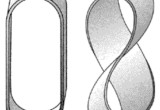Women’s Leadership – What does that mean to you? The word “leader” is a loaded term. One research study found that when the word “leader” was presented in a written job description for tenure positions, there was a different impact on the promotion of men and women in elite medical schools. This impact is implicit, especially in regard to gender and implicit bias where our cognitive processing can, against our own conscious intentions, influence our actions. There are small differences in evaluation and treatment that are called “accumulative disadvantages.” These create long-term consequences that result in large disparities in salary, promotion, and prestige. A computer simulation model of promotion with only one-percent variability with equal numbers of men and women resulted with the top level of the hierarchy being 65-percent male. Explicitly we have seen a lot of changes in society with more women in medicine and graduate school than ever before. So why worry about the glass ceiling? Because research shows that when men or women think of “leader,” they “think male.” We often do things without letting ourselves know.
In my research I have developed a model identifying five primary barriers to Women’s Leadership: THE FIVE BARRIERS TO WOMEN’S LEADERSHIP
Defining your motivation for leadership is important. It might mean advancing in your career, but it also might mean settling work-family conflict. In the hundreds of conversations and interviews I have had with women, this topic is always uppermost. In Rosser’s, The Science Glass Ceiling, a study of 450 women scientists, up to 78% of respondents found balancing work with family as the most significant challenge facing women scientists. One woman physician-professor I interviewed (who had a female mentor who helped her with work-life balance) said she did not allow herself to be devalued, that she was working part-time because she had children, “no excuses.” She later got tenure.
Parker Palmer, a noted author, educator, and activist, talks about the consequences of living the divided life in our society, and asks “Is this person living the same life on the inside as they are on the outside?” The sense of incongruity that we sense in others and ourselves undermines our energy and capacity for good work. Women need to recognize their incongruity with their surroundings before it’s too late. An armored life is not a sane life. When you are guarded and overly self-protective, you cannot be authentic and fully express your talents in the workplace.
 The Möbius strip is an appropriate metaphor. The Möbius strip has several curious properties. A line drawn starting from the seam down the middle will meet back at the seam but at the “other side.” If continued the line will meet the starting point and will be double the length of the original strip. This single continuous curve demonstrates that the Möbius strip has only one boundary whereas a circular strip has two.
The Möbius strip is an appropriate metaphor. The Möbius strip has several curious properties. A line drawn starting from the seam down the middle will meet back at the seam but at the “other side.” If continued the line will meet the starting point and will be double the length of the original strip. This single continuous curve demonstrates that the Möbius strip has only one boundary whereas a circular strip has two.
This metaphor represents you as you integrate your “outside” with your “inside.” That’s what this project is about. Your work is to find your center, despite the barriers as illustrated in the model. Your center is invariably pulled in multiple directions, but you metaphorically turn and re-frame by integrating the evidence with your experience.
This is just the beginning.
Reflective Questions
- Define leadership.
- Describe what your leadership center looks like.

